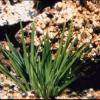Acorus gramineus
Scientific name: Acorus gramineus
Family: Acoraceae
Maximum size reached under cultivation: 15 - 30 cm (5.91 - 11.81 inch)
014
Recommended pH range: 6.5 - 7.5
Recommended water hardness: 4 - 18°dGH (71.43 - 321.43ppm)
0°C 32°F30°C 86°F
Recommended temperature range: 22 - 28 °C (71.6 - 82.4°F)
Preferred propagation method: Divisions
Native to: East Asia
Growth rate: Slow
Recommended substrate: Gravel
Lighting requirements: Bright
Ideal placement in tank: Background
Common Names
Dwarf Sedge, Japanese Rush, Japanese Sweet Flag
Origin
Acorus gramineus, commonly known as Dwarf Sedge or Japanese Sweet Flag, originates from Japan. Belonging to the Acoraceae family, it is highly valued for its ornamental foliage and ability to thrive in moist, semi-aquatic environments.
Quick Overview
- 🌿 Ideal For: Ponds, paludariums, terrariums
- 🧑🌾 Difficulty Level: Easy
- 💡 Lighting: Moderate to high
- 🌡️ Temperature: 72°F to 82°F (22°C to 28°C)
- ⚗️ pH: 6.5 to 7.5
Growing Conditions
Despite being used in aquascaping, Acorus gramineus is not a true aquatic plant and does not thrive when fully submerged for long periods. It is best suited for paludariums, terrariums, and as a marginal plant in ponds, where its roots can remain moist while its foliage is exposed to the air. Its slim, grass-like leaves can add a delicate texture to your aquascape, enhancing its natural look.
Planting Area
This versatile plant excels when placed in moist areas around pond edges, stream banks, or the shallow zones of paludariums and terrariums. Its compact growth and vibrant green foliage create an attractive foreground or border in any moisture-rich setup.
Propagation
Acorus gramineus propagates through division. To propagate, carefully remove the plant from its substrate and divide the root mass into smaller sections, each containing a portion of roots and foliage. Plant these divisions in moist soil along pond edges, paludariums, or terrariums. Allow them to acclimate and develop new roots before settling them into their final position.
Difficulty
Growing Acorus gramineus is relatively easy, particularly in ponds, paludariums, or terrariums. Regular maintenance, such as trimming and pruning, is recommended to prevent overgrowth. When planted in suitable conditions, it requires minimal care, making it an excellent choice for beginners and seasoned aquarists alike.
Lighting and Water Conditions
Acorus gramineus prefers moderate to high lighting but can tolerate lower light levels in semi-aquatic environments. For optimal growth, provide a nutrient-rich substrate and keep the roots consistently moist. The plant thrives in a pH range of 6.5 to 7.5, with temperatures between 72°F to 82°F (22°C to 28°C). When grown near ponds or in terrariums, occasional misting helps maintain humidity and supports healthy foliage.
Uses in Aquascaping and Pondscaping
Though unsuitable for fully submerged aquariums, Acorus gramineus brings texture and visual interest to pond edges, paludariums, and terrariums with its slender, upright leaves. It creates natural hiding spots for small amphibians and terrestrial creatures. In pondscaping, pair it with other marginal plants like Cryptocoryne species or Eleocharis to create a lush and vibrant water feature.
Potential Issues
While Acorus gramineus is generally hardy, it may face some issues if not kept in its ideal conditions:
- 🚫 Browning or Yellowing Leaves: Prolonged submersion or poor lighting can cause damage.
- 📉 Poor Growth: Low nutrient availability or dry conditions may inhibit growth.
- 💧 Algae Growth: Ensure water circulation in ponds to avoid algae on foliage.
Monitoring light and moisture levels will help prevent these potential issues. Adjust its environment as needed to ensure its continued health and vibrancy.
Overall Appeal
Acorus gramineus is a versatile, low-maintenance plant that adds natural charm to ponds, paludariums, and terrariums. Its vibrant green, grass-like foliage, combined with its ease of care, makes it a favorite among aquascapers and pond enthusiasts. By providing proper care, this plant will thrive and enhance any semi-aquatic or moisture-rich environment.



 Acorus gramineus pusillus
Acorus gramineus pusillus